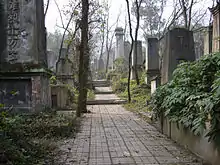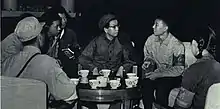Violent Struggle
The Violent Struggle (simplified Chinese: 武斗; traditional Chinese: 武鬥; pinyin: wǔdòu), also known as Wudou or Factional Conflicts, refers to the violent conflicts between different factions (mostly of Red Guards and "rebel groups") during the Chinese Cultural Revolution (1966-1976).[2][3][4][5][6] The factional conflicts started in Shanghai and Chongqing in December 1966, and then spread to other areas of China in 1967 which brought the country to the state of civil war.[6][7][8][9][10] Most violent struggles took place after the power seizure of rebel groups, and gradually grew out of control in 1968, forcing the Central Committee of the Communist Party of China as well as the Chinese government to take multiple inventions in the summer of 1968.[11]

Weapons used in armed conflicts included some 18.77 million guns (some say 1.877 million[12]), 2.72 million grenades, 14,828 cannons, millions of other ammunitions and even armored cars and tanks.[6] Researchers have pointed out that the death toll in violent struggles ranged from 300 thousand to 500 thousand, while certain documents from the Communist Party of China have revealed that 237,000 people were killed and another 7,030,000 were injured or permanently disabled.[6][13][14][15][16] Notable violent struggles include the battles in Chongqing, in Sichuan, and in Xuzhou.[1][6][17]
History
Origins
The violent faction clashes in Shanghai and Chongqing in December 1966 were regarded as the first large-scale violent struggles in mainland China.[18][19] In January 1967, factions in Shanghai started the "January Storm" during which Shanghai People's Commune was established.[20][21] After receiving the support from Mao Zedong himself, the "Shanghai model" spread to other regions of China where factions began to grab power from the local governments, establishing the revolutionary committees.[6][20][21] The violent struggles across China escalated significantly in the summer of 1967 after Jiang Qing, the wife of Mao Zedong, promoted the idea of "Wen Gong Wu Wei (文攻武卫)", meaning "attack with reason, defend with force".[22][23]
The Cultural Revolution brought to the forefront numerous internal power struggles within the Communist party, many of which had little to do with the larger battles between Party leaders, but resulted instead from local factionalism and petty rivalries that were usually unrelated to the "revolution" itself. Because of the chaotic political environment, local governments lacked organization and stability, if they existed at all. Members of different factions often fought on the streets, and political assassinations, particularly in predominantly rural provinces, were frequent. The masses spontaneously involved themselves in factions and took part in open warfare against other factions. The ideology that drove these factions was vague and sometimes non-existent, with the struggle for local authority being the only motivation for mass involvement.
Escalation

Early phase of faction clashes involved mass brawls and throwing bricks only. However, after the Wuhan incident on July 20, 1967, Jiang Qing thought that counter-revolutionaries appeared in the military and thus publicly proposed the idea of "Wen Gong Wu Wei (文攻武卫)", or "attack with reason, defend with force".[22] Jiang's idea was published by Wenhui Bao on July 23, and the faction clashes subsequently entered the phase in which weapons such as guns, grenades, cannons and even tanks were used in battles, bringing the country to the state of civil war.[22][23]
According to some documents, different factions received weapons from their respective supporting army branches, while some factions even raided local armories or created their own guns.[6][23] The total number of guns used in the violent struggles was approximately 18.77 million[6] (some say 1.877 million[12]).
End
In the summer of 1968, the violent struggles had grown out of control in a number of places, forcing the Central Committee of the Communist Party of China to issue several announcements to stop the battles.[11] As a result, the factions gradually turned in their weapons and dissolved their armed teams.
Death toll
Chinese researchers have pointed out that the death toll in violent struggles ranged from 300 thousand to 500 thousand.[6][13][14] Serious cases of violent struggles included the battles in Luzhou, Xuzhou and Chongqing, each of which saw deaths of at least thousands of people.
Certain documents (建国以来历史政治运动事实) from the Communist Party of China have stated that 237,000 people were killed and another 7,030,000 were injured or permanently disabled.[6][14][15][16]
References
- Buckley, Chris (2016-04-04). "Chaos of Cultural Revolution Echoes at a Lonely Cemetery, 50 Years Later". The New York Times. ISSN 0362-4331. Retrieved 2020-02-16.
- Jian, Guo; Song, Yongyi; Zhou, Yuan (2015-07-23). Historical Dictionary of the Chinese Cultural Revolution. Rowman & Littlefield. ISBN 978-1-4422-5172-4.
- Jian, Guo; Song, Yongyi; Zhou, Yuan (2009-09-17). The A to Z of the Chinese Cultural Revolution. Scarecrow Press. ISBN 978-0-8108-7033-8.
- Walder, Andrew G. (December 2006). "Factional Conflict at Beijing University, 1966–1968" (PDF). The China Quarterly. 188: 1023–1047. doi:10.1017/S0305741006000531.
- Andreas, Joel (August 2002). "Battling over Political and Cultural Power during the Chinese Cultural Revolution". Theory and Society. 31 (4): 463–519. doi:10.1023/A:1020949030112. JSTOR 3108513.
- Song, Yongyi. "Chronology of Mass Killings during the Chinese Cultural Revolution (1966-1976)". Sciences Po. Retrieved 2020-02-16.
- Phillips, Tom (2016-05-11). "The Cultural Revolution: all you need to know about China's political convulsion". The Guardian. ISSN 0261-3077. Retrieved 2020-02-16.
- "August 2016: The Chinese Cultural Revolution at Fifty | Origins: Current Events in Historical Perspective". Ohio State University. Retrieved 2020-02-16.
- "1980年:法拉奇对话邓小平". Phoenix New Media (in Chinese). 2013-03-19. Archived from the original on 2021-01-03. Retrieved 2020-02-16.
- "1980年邓小平接受外媒专访:坦率回应敏感话题". Sina (in Chinese). 2014-08-26. Archived from the original on 2021-01-03. Retrieved 2020-02-16.
- "1968年大事记". The Central Government of the People's Republic of China (in Chinese). 2012-02-08. Archived from the original on 2020-08-21. Retrieved 2020-04-01.
- Yang, Jisheng (2017-07-04). 天地翻覆: 中国文化大革命历史 (in Chinese). 天地图书.
- Ding, Shu. "文革死亡人数统计为两百万人". Independent Chinese PEN Center (in Chinese). Retrieved 2020-02-16.
- Song, Yongyi. "文革中"非正常死亡"了多少人?". China in Perspective (in Chinese). Retrieved 2020-02-16.
- "文革五十周年:必须再来一次反文革". www.hybsl.cn (in Chinese). Retrieved 2020-06-09.
- "1967:"革命样板戏"开始推行_大国脚印:网友心中60年最具影响力的60件事". Tencent (in Chinese). Archived from the original on 2020-01-07. Retrieved 2020-06-09.
- Ramzy, Austin (2016-05-14). "China's Cultural Revolution, Explained". The New York Times. ISSN 0362-4331. Retrieved 2020-02-16.
- He, Shu (2010-08-01). 為毛主席而戰——文革重慶大武鬥實錄 (in Chinese). Joint Publishing HK. ISBN 978-962-04-2995-8.
- Frazier, Mark W. (2019-05-16). The Power of Place: Contentious Politics in Twentieth-Century Shanghai and Bombay. Cambridge University Press. ISBN 978-1-108-48131-1.
- "China: The January Storm". Institute of Peace and Conflict Studies. Retrieved 2020-04-03.
- "A Short History of Shanghai". New York Times. Retrieved 2020-04-03.
- "Glossary (English to Chinese)" (PDF). The British Museum.
- "(2)"文攻武卫"". Renmin Wang. 2009-05-26. Archived from the original on 2020-06-22. Retrieved 2020-04-03.